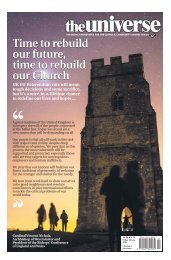The Universe 5th August 2016
The weekly newspaper for the Catholic community across the UK
The weekly newspaper for the Catholic community across the UK
Create successful ePaper yourself
Turn your PDF publications into a flip-book with our unique Google optimized e-Paper software.
u • TRAVEL 12 FRIDAY 05.08.16<br />
Gliding slowly along the motionless<br />
Douro River, we slice through nearperfect<br />
reflections of undulating hills,<br />
all etched with vine terraces resembling<br />
contours on a map. Sandeman,<br />
Taylor’s, Graham’s – I pick out port<br />
producers whose bottles fill my<br />
drinks cabinet at home.<br />
We’re tracing a centuries-old route<br />
used to transport the Portuguese fortified<br />
wine to the coast; only these<br />
days, a flotilla of traditional rabelo<br />
boats carry tourists rather than heavy<br />
wooden casks. <strong>The</strong> world’s oldest regulated<br />
wine region, afforded Unesco<br />
World Heritage status in 2001, has<br />
been attracting river cruisers for<br />
many years, with land stays possible<br />
in a collection of simple quintas.<br />
But in the last 12 months, the<br />
launch of two boutique hotels has<br />
broadened the Douro’s appeal. Last<br />
summer, Six Senses announced a<br />
property in Lamego as their first European<br />
outpost and in April, the Taylor’s<br />
Port family (now part of the<br />
Fladgate Partnership) re-opened Vintage<br />
House Hotel – a property they’d<br />
owned 10 years previously.<br />
Coupled with the recent completion<br />
of a new mountain tunnel, which<br />
cuts journey time to gateway city<br />
Porto by 30 minutes to an hour and a<br />
half, this scenic wine lovers’ region is<br />
ripe for visiting.<br />
‘‘<br />
In the last 20 years,<br />
many young winemakers<br />
have switched to making<br />
table wine. As well as being<br />
quicker and cheaper to<br />
produce, it’s also winning<br />
the region top industry<br />
accolades.<br />
u<br />
Travel<br />
By Sarah Marshall<br />
Our wooden boat docks at the<br />
small, sleepy village of Pinhao, famous<br />
for its azulejo-tiled train station depicting<br />
bucolic scenes of the wine harvest.<br />
Several times a day, trains toot<br />
along the line, making a two-hour<br />
journey through the hills to Porto.<br />
From the waterfront, it’s a hop, skip<br />
and port-addled stumble to the Vintage<br />
House Hotel, where swallows flit<br />
through orange trees and trellises are<br />
festooned with magenta bougainvillea.<br />
“We’ve worked hard to retain features<br />
of the original warehouse building,”<br />
explains General Manager Paulo<br />
Santos, as we admire the gnarled oak<br />
beams of the Library Room, supported<br />
by original granite columns.<br />
Seven new suites have been added,<br />
bringing the total number of rooms to<br />
47 – all with views to the river, and<br />
colour schemes have been brightened<br />
up a notch to bring the feeling of outside<br />
in. I stay in one of the Master<br />
Suites, notable for its playful Christian<br />
Lacroix bathroom wallpaper, not<br />
to mention its sheer size – bigger than<br />
most city apartments.<br />
In the next couple of years, there<br />
are plans to build a spa and gym, but<br />
when dealing with a place this peaceful<br />
and protected, it’s a respectful case<br />
of “slowly, slowly”, explains Paulo.<br />
<strong>The</strong> hotel’s relaxed, rustic restaurant<br />
is a fine showcase for produce<br />
from the region, including lamb and<br />
veal reared in local hill villages, and<br />
peppery olive oil.<br />
But for a real taste of the Douro’s<br />
liquid assets, I visit the Fladgate Partnership’s<br />
neighbouring Quinta da<br />
Roeda wine estate, where a visitor<br />
centre is housed in the former stables.<br />
Filipe Carvalho, Wine Tourism<br />
Manager, estimates there are 30,000<br />
wine growers in the Douro Valley, but<br />
since the 18th century, land has been<br />
slowly consolidated and now British<br />
companies Taylors and Symington<br />
own 50 per cent of it.<br />
In the last 20 years, many young<br />
winemakers have switched to making<br />
table wine. As well as being quicker<br />
and cheaper to produce, it’s also winning<br />
the region top industry accolades.<br />
Filipe is more of a traditionalist.<br />
“We’ve been making port using the<br />
same methods for hundreds of years,<br />
although we do have a few innovations,”<br />
he says, pouring an aperitif I<br />
soon identify as synonymous with<br />
summertime – a Croft Pink rose port<br />
and tonic on ice.<br />
During harvest time, most work in<br />
the vineyards is done by hand – or<br />
foot. Filipe claims grapes tramped by<br />
humans taste far superior to those<br />
churned in cold stainless steel vats.<br />
“It works out more expensive,” he<br />
admits. “But this is still a family business<br />
and social sustainability is more<br />
important than profit.”<br />
Adrian Bridge, CEO of Fladgate<br />
Partnership, and a member of the<br />
Taylor’s family, envisages the Douro<br />
as a centre for wine tourism. Six<br />
years ago, he opened Portugal’s first<br />
wine hotel, the award-winning Yeatman,<br />
in Porto, and he hopes success<br />
will trickle along the river.<br />
Set amid terracotta-roofed port<br />
warehouses in Vila Nova de Gaia, the<br />
elevated 82-room property gazes out<br />
across the mouth of the Douro to a<br />
piled-high stack of historic buildings<br />
that earned Porto Unesco classification.<br />
Rooms are named after national<br />
winemakers, and corridors are decorated<br />
with vintage maps and paintings<br />
celebrating Portugal’s place in the<br />
world of exploration and travel. Guests<br />
can cool off in an outdoor decantershaped<br />
swimming pool, and a staircase<br />
winding through an enormous wine<br />
barrel connects treatment rooms in the<br />
Caudalie Vinotherapie spa.<br />
Appropriately, it also boasts the<br />
city’s only Michelin-star restaurant. Sat<br />
eye level with the clouds on a<br />
panoramic terrace, I enjoy Chef Ricardo<br />
Costa’s sublime 10-course tasting<br />
menu while watching a tangerine<br />
sun melt into the Atlantic coastline, as<br />
elegant peacocks strut around my feet.<br />
Peanut-laced crabmeat served with<br />
a dash of beer and braised lime<br />
evokes days at the beach, and a<br />
tomato tartare sprayed with cool<br />
foam is a chillingly pleasant summer<br />
treat. <strong>The</strong> marathon meal is also an<br />
education in Portuguese wines, with<br />
my favourite, a Soalheiro Alvarinho<br />
2014, served by the jeroboam. Tourist<br />
attractions in Gaia revolve around the<br />
Portugal’s valley<br />
of plenty
















